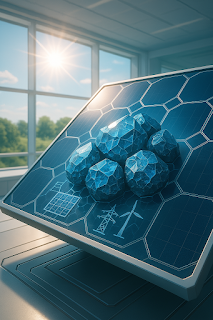The solar energy industry has witnessed several advancements in recent years, with perovskite solar cells emerging as one of the most promising technologies. A new crystallization strategy has recently enhanced perovskite solar cell efficiency to an impressive 26.1%, addressing many of the stability challenges that have hindered their widespread adoption. This breakthrough could be a game-changer for the future of solar power, offering a more efficient and sustainable alternative to traditional silicon-based solar cells. In this blog, we’ll dive into how this new strategy works, its implications for the energy industry, and what it means for the future of renewable energy.
Understanding Perovskite Solar Cells
What Are Perovskite Solar Cells?
Perovskite solar cells (PSCs) are made from a unique material structure that mimics the natural mineral perovskite. These cells are known for their high efficiency, low production costs, and ability to be fabricated on flexible substrates, offering a range of possibilities that traditional silicon-based cells cannot match.
Why Perovskite?
Perovskite materials have the potential to surpass silicon in terms of both efficiency and cost-effectiveness. However, there have been persistent challenges with the stability of these cells, especially under harsh environmental conditions, such as high temperatures and humidity.
The Breakthrough: Crystallization Strategy Boosts Efficiency
What Is the New Crystallization Strategy?
Researchers have developed a new method to enhance the crystallization process during the manufacturing of perovskite solar cells. The innovation lies in controlling the grain boundaries during crystallization, which allows for the formation of larger, more uniform crystals. This leads to a more stable structure and improved performance in terms of light absorption and electron transport.
Efficiency Leap to 26.1%
With this new strategy, perovskite solar cells have achieved a record-breaking efficiency of 26.1%. This is a significant improvement over previous generations of PSCs, which typically hovered around 20-22%. The higher efficiency ensures that these cells can generate more energy from the same amount of sunlight, making them a more attractive option for both residential and commercial solar installations.
Key Advantages of the New Crystallization Strategy
Enhanced Stability
One of the most important outcomes of this new approach is the stability it brings to perovskite solar cells. Unlike earlier versions, which tended to degrade over time, the newly developed cells can maintain their efficiency for longer periods. This makes them more reliable for long-term use, an essential requirement for solar technology.
Cost-Effectiveness
The new crystallization strategy can potentially lower production costs. The materials used in perovskite cells are cheaper than silicon, and the ability to mass-produce these high-efficiency cells without compromising stability could dramatically reduce the cost per watt of solar power.
Flexibility and Versatility
This breakthrough also paves the way for more flexible solar panels. With perovskite materials, solar cells can be produced on lightweight, flexible substrates, making them ideal for use in a variety of settings where traditional solar panels might not be feasible, such as on windows or portable devices.
Implications for the Solar Industry
Impact on Solar Efficiency and Market Adoption
This new advancement could accelerate the adoption of perovskite solar cells in commercial and residential applications. With the promise of higher efficiency, lower costs, and better durability, the perovskite technology could compete directly with traditional silicon-based cells, expanding the potential market for solar power.
The Road Ahead for Solar Power
As the energy transition accelerates, the integration of efficient and stable perovskite solar cells could be crucial in meeting global renewable energy goals. Their scalability and lower production costs make them a significant contender in the race for a sustainable, solar-powered future.
Conclusion
The new crystallization strategy that boosts the efficiency of perovskite solar cells to 26.1% marks a significant milestone in the development of solar power technology. With improved efficiency, stability, and cost-effectiveness, perovskite cells are now closer than ever to being a dominant force in the solar industry. This breakthrough brings us a step closer to a future where solar power is not only more accessible but also more sustainable, making a vital contribution to combating climate change and securing energy independence.


No comments:
Post a Comment